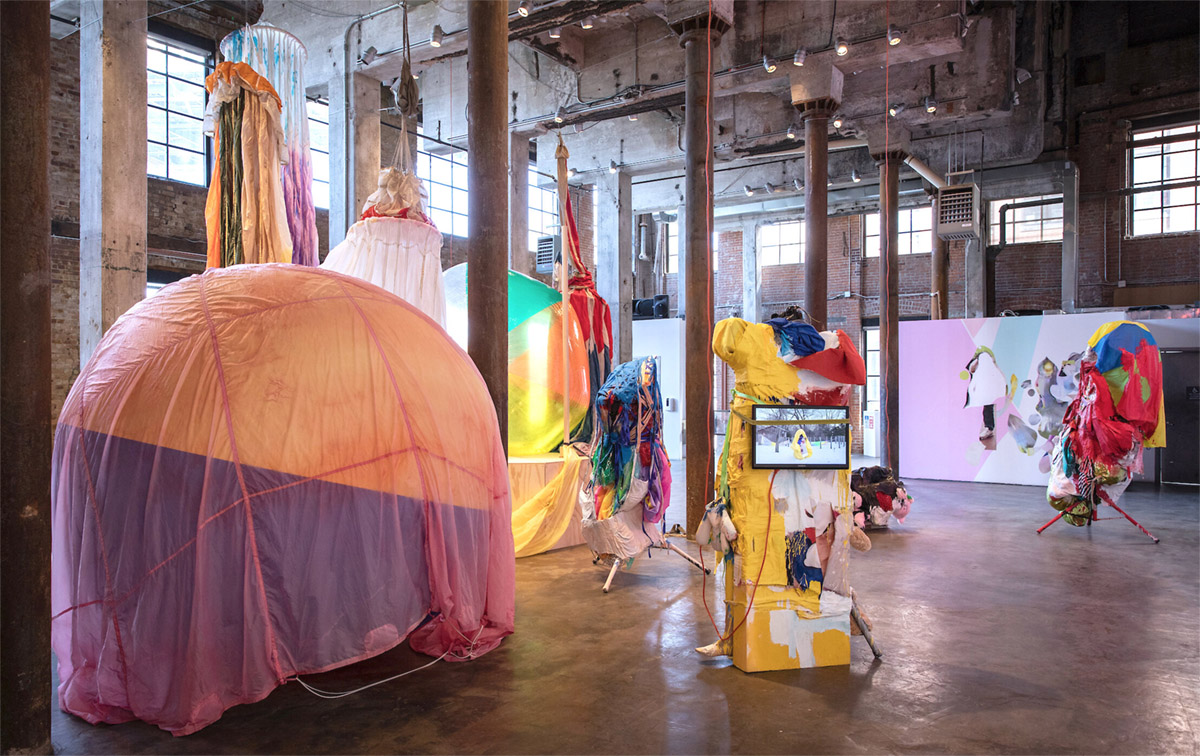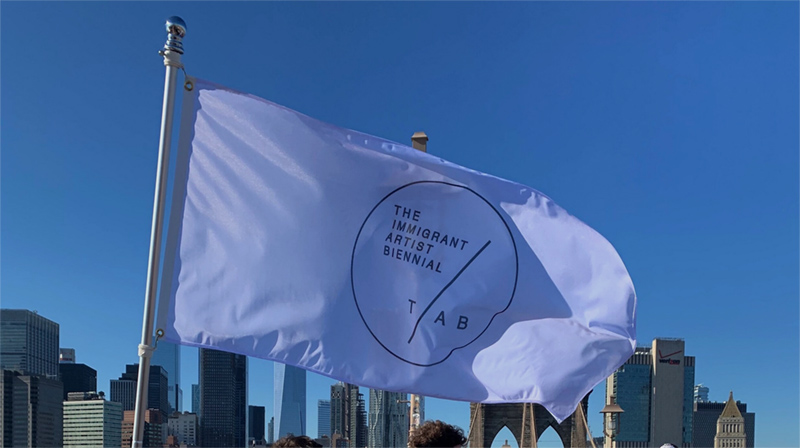The Immigrant Artist Biennial
Katya Grokhovsky Interview
When I conceived of TIAB, I was initially inspired by my own experience of immigration and longing to belong. I was looking for a suitable format to realise my vision, interested in establishing a supportive recurring platform and a community, which can morph and change thematically and logistically etc with each iteration. I toyed around with a variety of containers, including an annual festival, a series of exhibitions etc but the proposition of a Biennial event seemed to be the most fitting umbrella which could house many ideas simultaneously. I do not take the notion of the ‘Biennial’ lightly and am acutely aware of its connotation, but the use of it is intentional, as I have dreamed of expanding its meaning and boundaries through focusing on marginalised voices specifically.
Sluice: TIAB has a flag, in the past you’ve said “art is my country”, I know as an immigrant myself I no longer belong where I came from nor where I find myself now. I wonder if with the TIAB flag you’re in some way conceptually staking out a territorial home for your assembled compatriots?
Katya Grokhovsky: As a double immigrant I no longer belong to any place anymore and so Art is the territory I carved out, claimed and now call home. This home contains the constructed and found family I had to seek out as an immigrant and an artist. As TIAB is nomadic and essentially has no permanent space, I felt I needed to create an identity for it, to conceptually establish it’s own territory, even if fictional and somewhat roaming.

Sluice: You came from Ukraine via Australia to the US. The US is famous for selling itself as a land of immigrants, welcoming of the world’s ‘huddled masses’. Every country mythologises itself in some way and the truth generally lies by degrees elsewhere, as an immigrant to the US how do you feel your ‘otherness’ plays both for and against you.
Katya Grokhovsky: Until very recently, I felt the substantial burden of ‘otherness’ and the ‘outsider’ status, even in bureaucratic language: immigrant = ‘alien’ in the US, has isolated me and made me quite insecure until I harnessed the rage it produced and felt confident enough to make it an asset. From my experience, one of the most prevalent characteristics of the society in the US is the distrust of others, especially those who might in any way, be not “like the rest of us”. It affects lives, creates ignorance, hatred and unnecessary obstacles and struggles
for immigrants in all aspects of life. Eventually, in order to thrive here,
I had to embrace whatever cultural and identity ‘differences’ I brought to the table as a unique advantage.

Sluice: You founded the open-forum platform Feminist Urgent. Is it specifically important that TIAB is led and run exclusively by women?
Katya Grokhovsky: The premise of TIAB is to support and give space to marginalised artistic voices, who have been historically excluded by the mainstream art world, including women, trans and non-binary people who are still in this category. However, the all-female team grew organically, yet unsurprisingly, through the sheer fact of them mainly being interested and volunteering to be behind the mission and the curtain of the project.
Sluice: One of the driving forces behind this edition of the Sluice magazine is the idea of the migrant’s gaze perhaps offering a different perspective to that of the native-born citizen. What is it that you feel an immigrant offers that someone living in their birth country may not?
Katya Grokhovsky: I believe an immigrant can offer an invaluable, honest, critical and politically-charged evaluation of a society from an outsider’s point of view. Immigrant artists often deal with difficult and meaningful issues, which they witness first-hand, and which affect them personally, generating profoundly evocative and universally relatable work as a result.
Sluice: Sluice is preoccupied by the artist-led project as an extension of the artist’s practice. TIAB is clearly an outgrowth of your personal history as an immigrant and of your studio practice. Are you keen for your studio practice to be identified by themes of immigration or are you happy for it to be more generalised as dealing with issues of the ‘other’, exclusion, belonging, transitory liminal existence etc etc – themes not exclusive to the immigrant?
Katya Grokhovsky: I am an immigrant, but I am also a woman, a human and a citizen of a society. I spent my adult life migrating, so of course themes of migration permeate my practice throughout, and it is the lens I see many things through, but I also explore other aspects of life. Womanhood, gender oppression,
loss, nostalgia, death, love, identity construct and living through Socialism in The Soviet Union and Capitalism and Consumerism in Australia and the US reoccur in my work.
Sluice: The plight of the immigrant can be couched within the dynamic of the guest. This provides a framework to understand societal friction on a domestic scale: In your work Temporary Habitat in particular there’s a real feeling of you setting up residence in the gallery and confrontationally declaring your intention to stay. It draws out the imagery of the unwanted house guest, or the guest that doesn’t know when to leave. Am I imagining this undercurrent of menace?
Katya Grokhovsky: In Australia immigrants are often called the offensive acronym for the term ‘welcome overseas guests’. When said to someone, it is intended as an insult, implying you are an unwanted entity and must leave at some point. In the US we are again, ‘aliens’, which is of course another way of segregating and differentiating, calling a person a type of non-human, from outer space, who will likely have to leave or be chased out. I have been both and the feeling and fear of ‘temporality of existing in
a place is forever with me. The work TemporaryHabitatisadeclarationof a temporary residence, a homemaking gesture, which points to a time of waiting for permission to stay, ready to go at moment’s notice. I guess the menacing effect can be perceived in the presence of the inhabitant, who is claiming space, but I see it more as a metaphor of an immigrant’s life. 
Main image features Katya Grokhovsky at the Immigrants Ball at the Flux Factory in 2018, Photo by Walter Wlodarczyk
katyagrokhovsky.net
theimmigrantartistbiennial.com
This interview features in the Autumn 2021 edition of the Sluice_magazine
